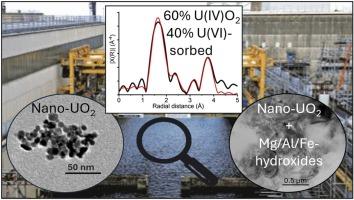乏核燃料储存池流出物中的纳米颗粒和胶体铀和钚。
IF 11.3
1区 环境科学与生态学
Q1 ENGINEERING, ENVIRONMENTAL
引用次数: 0
摘要
胶体由于具有调动放射性核素的潜力,对核退役和处置提出了挑战。英国塞拉菲尔德核设施的废物回收和废核燃料储存池和放射性废物筒仓的退役是高度优先考虑的事项。这里描述的微粒来自已有60年历史的设施,为研究放射性核素在水生工程储存环境中的长期命运提供了一个独特的机会。从一个遗留池塘中获得放射性废水,并使用超滤、透射电子显微镜(TEM)和锕系元素L3边缘x射线吸收光谱(XAS)对其进行表征。TEM分析显示离散的uo2样纳米颗粒,尺寸为5-10 nm,通常与Mg-Al-和Fe-(氧合)氧化物胶体相共生。铀的XAS表明铀氧化态与EXAFS混合,表明U(IV)氧化物纳米颗粒和吸附U(VI)。Pu XANES鉴定出Pu(IV)为主要氧化态。U和Pu都与大的Mg/Al-和Fe-(氧合)氧化物团聚体结合,突出了伪胶体形成的潜力,解释了当前颗粒过滤/减除技术的基础。这项研究使用先进技术检查了来自复杂的高放射性设施的新样品,提供了对这些环境中放射性核素形态和流动性的新理解,并为放射性废水的处理和处置提供了信息。本文章由计算机程序翻译,如有差异,请以英文原文为准。

Nanoparticulate and colloidal uranium and plutonium in spent nuclear fuel storage pond effluents.
Colloids present a challenge for nuclear decommissioning and disposal due to their potential to mobilise radionuclides. Waste retrieval and decommissioning of storage ponds for spent nuclear fuel and silos for radioactive waste at the Sellafield nuclear facility, UK, are high priorities. The particulates characterised here originate from facilities >60 years old and provide a unique opportunity to investigate the long-term fate of radionuclides in an aquatic, engineered storage environment. Radioactive effluents were obtained from a legacy pond and characterised using ultrafiltration, transmission electron microscopy (TEM) and actinide L3 edge X-ray absorption spectroscopy (XAS). TEM analysis showed discrete UO2-like nanoparticles, 5-10 nm in size, often co-associated with Mg-Al- and Fe-(oxyhydr)oxide colloidal phases. Uranium XAS indicated a mix of uranium oxidation states with EXAFS suggesting U(IV)-oxide nanoparticles and sorbed U(VI). Pu XANES identified Pu(IV) as the dominant oxidation state. Both U and Pu associates with large, Mg/Al- and Fe-(oxyhydr)oxide agglomerates highlights the potential for pseudo-colloid formation, explaining the basis of current particle filtration / abatement of technology. This study, which examines novel samples from a complex, highly radioactive facility using advanced techniques, provides a new understanding of radionuclide speciation and mobility in these environments and informs radioactive effluent treatment and disposal.
求助全文
通过发布文献求助,成功后即可免费获取论文全文。
去求助
来源期刊

Journal of Hazardous Materials
工程技术-工程:环境
CiteScore
25.40
自引率
5.90%
发文量
3059
审稿时长
58 days
期刊介绍:
The Journal of Hazardous Materials serves as a global platform for promoting cutting-edge research in the field of Environmental Science and Engineering. Our publication features a wide range of articles, including full-length research papers, review articles, and perspectives, with the aim of enhancing our understanding of the dangers and risks associated with various materials concerning public health and the environment. It is important to note that the term "environmental contaminants" refers specifically to substances that pose hazardous effects through contamination, while excluding those that do not have such impacts on the environment or human health. Moreover, we emphasize the distinction between wastes and hazardous materials in order to provide further clarity on the scope of the journal. We have a keen interest in exploring specific compounds and microbial agents that have adverse effects on the environment.
 求助内容:
求助内容: 应助结果提醒方式:
应助结果提醒方式:


